Computational Investigation on the Performance Increase of a Small Industrial Diesel Engine Regarding the Effects of Compression Ratio, Piston Bowl Shape and Injection Strategy
Abstract
:1. Introduction
2. Materials and Methods
2.1. Test Bench and Operating Points
2.2. Numerical Setup
2.3. Model Validation
3. Results
3.1. Geometry Variation
3.2. Investigation of Compression-Ratio-Variation Methods
3.3. Influence of Injector Positioning
3.4. 1D Simulation for Fuel-Mass Variation
3.5. Influence of Methods for Increased Fuel-Mass Injection
3.6. Results of Reduced Compression Ratio and Higher Fuel Mass with Different Geometries
4. Conclusions
- Only one of the eight geometries investigated showed, due to a larger bottom-bowl radius, an improvement over the series in terms of torque and all the specific emissions evaluated. Two other geometries showed potential with regard to specific NOx emissions, despite their very different shapes.
- Due to the high wall-heat losses caused by the extended fire bar, this compression-ratio-adaptation variant resulted in lower combustion-chamber temperatures. This reduced the effective mean pressure and decreases NOx emissions. Besides that, CO and UHC emissions increased with this variant.
- The CR reduction required an adjustment of the fuel-spray orientation. In particular, the variant with an adjusted spray angle showed great potential, with regard to all the specific emissions considered with unchanged torque.
- For the increased fuel-mass injection, the enlargement of the injector-hole diameter was selected. The reason for this was that the lowest specific fuel consumption and the lowest NOx emissions could be achieved with this method.
- Finally, for geometry V6 and CR 14.5, a maximum mean pressure increase of 15%, with 15% reduced CO and 60% reduced UHC emissions, could be achieved. At a compression ratio of 16.0, this geometry showed the lowest specific consumption. Geometries V4 and V8 achieved up to 12% lower NOx emissions for both compression ratios.
Author Contributions
Funding
Institutional Review Board Statement
Informed Consent Statement
Acknowledgments
Conflicts of Interest
References
- Cowland, C.; Gutmann, P.; Herzog, P. Passenger Vehicle Diesel Engines for the US; SAE Technical Paper 2004-01-1452; SAE: Warrendale, PA, USA, 2004. [Google Scholar] [CrossRef]
- Pischinger, F.F. The diesel engine for cars—Is there a future? J. Eng. Gas Turbines Power 1998, 120, 641–647. [Google Scholar] [CrossRef]
- Yadav, P.; Saravanan, C.G.; Edward, J.G.; Perumal, R. Experimental and Numerical Investigation of Flow and Combustion in a DI Diesel Engine with Different Piston Geometries; SAE Technical Paper 2015-01-0378; SAE: Warrendale, PA, USA, 2015. [Google Scholar] [CrossRef]
- Brijesh, P.; Abhishek, S.; Sreedhara, S. Numerical Investigation of Effect of Bowl Profiles on Performance and Emission Characteristics of a Diesel Engine; SAE Technical Paper 2015-01-0402; SAE: Warrendale, PA, USA, 2015. [Google Scholar] [CrossRef]
- Yoo, D.; Song, J.; Kim, Y.; Jung, W.; Kim, D. Fuel Consumption Improvement of 2.4L ULPC Diesel Engine by Optimizing the Combustion System—Nozzle, Swirl Ratio and Piston Bowl Geometry; SAE Technical Paper 2015-01-0785; SAE: Warrendale, PA, USA, 2015. [Google Scholar] [CrossRef]
- Splitter, D.; Wissink, M.; Kokjohn, S.; Reitz, R. Effect of Compression Ratio and Piston Geometry on RCCI Load Limits and Efficiency; SAE Technical Paper 2012-01-0383; SAE: Warrendale, PA, USA, 2012. [Google Scholar] [CrossRef]
- Hu, D.; Li, G.; Yu, Y. A Computational Investigation into the Effects of Piston Bowl Geometry on Fuel-Air Mixing and Performance in a High-Intensified Diesel Engine. In Proceedings of the International Conference on Materials for Renewable Energy and Environment, Chengdu, China, 19–21 August 2013. [Google Scholar] [CrossRef]
- Lee, J.; Lee, S.; Kim, J.; Kim, D. Bowl Shape Design Optimization for Engine-Out PM Reduction in Heavy Duty Diesel Engine; SAE Technical Paper 2015-01-0789; SAE: Warrendale, PA, USA, 2015. [Google Scholar] [CrossRef]
- Subramanian, S.; Rathinam, B.; Lalvani, J.; Annamalai, K. Piston Bowl Optimization for Single Cylinder Diesel Engine Using CFD; SAE Technical Paper 2016-28-0107; SAE: Warrendale, PA, USA, 2016. [Google Scholar] [CrossRef]
- Zolver, M.; Griard, C.; Henriot, S. 3D Modeling Applied to the Development of a DI Diesel Engine: Effect of Piston Bowl Shape; SAE Technical Paper Series 971599; SAE: Warrendale, PA, USA, 1997. [Google Scholar]
- Wen, M.; Li, Y.; Li, Y.; Tan, L.; Lyu, J. Numerical Simulation Analysis into Effects of Piston Bowl Geometry on Combustion Process for a High Power Density Diesel Engine; SAE Technical Paper 2015-01-1855; SAE: Warrendale, PA, USA, 2015. [Google Scholar] [CrossRef]
- Cró, N.R.; Ferreira, J.V.; Ribeiro, W.L.; Tanikawa, M.G. Computational Modeling of Internal Combustion Engines: Influence of Compression Ratio in the Indicated Performance Curves; SAE Technical Paper 2013-36-0349; SAE: Warrendale, PA, USA, 2013. [Google Scholar] [CrossRef]
- Annamalai, R.; Kuppusamy, R.; Krishnan Ramachandran, S. Effect of Piston Bowl Geometry and Different Injection Pressure on the Performance, Emission, and Combustion Characteristics of Diesel Engine Using Biodiesel Blend. Therm. Sci. 2018, 22, 1445–1456. [Google Scholar] [CrossRef]
- Shi, Y.; Reitz, R.D. Optimization study of the effects of bowl geometry, spray targeting, and swirl ratio for a heavy-duty diesel engine operated at low and high load. SAGE Int. J. Engine Res. 2008, 9, 325–346. [Google Scholar] [CrossRef]
- Dolak, J.G.; Shi, Y.; Reitz, R.D. A Computational Investigation of Stepped-Bowl Piston Geometry for a Light Duty Engine Operating at Low Load; SAE International; ISSN 0148-7191. SAE: Warrendale, PA, USA, 2010. [Google Scholar] [CrossRef]
- Quazi, M.A.; Singh, S.K.; Jadhao, M. Effect of Piston Bowl Shape, Swirl Ratio and Spray Angle on Combustion and Emission in Off Road Diesel Engine; SAE Technical Paper 2015-26-0142; SAE: Warrendale, PA, USA, 2015. [Google Scholar] [CrossRef]
- Lee, S.; Lee, J.; Hwang, S.; Wang, T.; Lee, Y. Design of combustion bowl geometry to meet final Tier 4 of 11 L non-road heavy-duty diesel engine with multi-dimensional combustion simulation. J. Mech. Sci. Technol. 2016, 30, 4373–4382. [Google Scholar] [CrossRef]
- Appukuttan, A.; Bisht, J.; Kaundabalaraman, K.; Rathi, H. Piston Bowl Design Optimization to Improve Low End Rated Torque in BS-VI Diesel Engine Based on Multi-Dimensional Combustion Simulation; SAE Technical Paper 2020-01-0241; SAE: Warrendale, PA, USA, 2020. [Google Scholar] [CrossRef]
- Cipolla, G.; Vassallo, A.; Catania, A.E.; Spessa, E.; Stan, C.; Drischmann, L. Combined Application of CFD Modeling and Pressure-Based Combustion Diagnostics for the Development of a Low Compression Ratio High-Performance Diesel Engine; SAE Technical Paper 2007-24-0034; SAE: Warrendale, PA, USA, 2007. [Google Scholar] [CrossRef]
- Hariram, V.; Vagesh Shangar, R. Influence of compression ratio on combustion and performance characteristics of direct injection compression ignition engine. Alex. Eng. J. 2015, 54, 807–814. [Google Scholar] [CrossRef] [Green Version]
- Gavade, S.; Bhargava, A.; Sonl, G.; Deshmukh, C. Optimization of Compression Ratio for DI Diesel Engines for Better Fuel Economy; SAE Technical Paper 2019-28-2431; SAE: Warrendale, PA, USA, 2019. [Google Scholar] [CrossRef]
- El Kassaby, M.; Nemit Allah, M.A. Studying the effect of compression ratio on an engine fueled with waste oil produced biodiesel/diesel fuel. Alex. Eng. J. 2012, 52, 1–11. [Google Scholar] [CrossRef] [Green Version]
- Funayama, Y.; Nakajima, H.; Shimokawa, K. A Study on the Effects of a Higher Compression Ratio in the Combustion Chamber on Diesel Engine Performance; SAE Technical Paper 2016-01-0722; SAE: Warrendale, PA, USA, 2016. [Google Scholar] [CrossRef]
- Minamino, R.; Kawabe, T.; Omote, H.; Okada, S. The Effect of Compression Ratio on Low Soot Emission from a Small Non-Road Diesel Engines; SAE Technical Paper 2013-24-0060; SAE: Warrendale, PA, USA, 2013. [Google Scholar] [CrossRef]
- Sheikh, S.; Gokhale, N.; Thatt, V.; Gandhi, N.; Deshmukh, B.; Aghav, Y.; Kumar, M.; Nandgaonkar, M.; Babu, M. Efficient Approach for Optimization of Piston Bowl Shape, Compression Ratio and EGR for DI Diesel Engine; SAE Technical Paper 2011-24-0013; SAE: Warrendale, PA, USA, 2011. [Google Scholar] [CrossRef]
- Gelner, A.; Höß, R.; Zepf, A.; Wachtmeister, G. Engine Operation Strategies for the Alternative Diesel Fuel Oxymethylene Ether (OME): Evaluation Based on Injection Rate Analyzer and 0D-/1D-Simulation; SAE Technical Paper 2021-01-1190; SAE: Warrendale, PA, USA, 2021. [Google Scholar] [CrossRef]
- Wang, B.-L.; Lee, C.-W.; Reitz, R.D.; Miles, P.C.; Han, Z. A generalized renormalization group turbulence model and its application to a light-duty diesel engine operating in a low-temperature combustion regime. Int. J. Engine Res. 2013, 14, 279–292. [Google Scholar] [CrossRef]
- Perini, F.; Zha, K.; Busch, S.; Reitz, R. Comparison of Linear, Non-Linear and Generalized RNG-Based k-epsilon Models for Turbulent Diesel Engine Flows. In SAE Technical Paper Series; SAE: Warrendale, PA, USA, 2017. [Google Scholar]
- Schmidt, D.P.; Rutland, C.J. A New Droplet Collision Algorithm. J. Comput. Phys. 2000, 164, 62–80. [Google Scholar] [CrossRef]
- Reitz, R.D.; Beale, J.C. Modeling Spray Atomization with the Kelvin-Helmholtz/Rayleigh-Taylor Hybrid Model. At. Sprays 1999, 9, 623–650. [Google Scholar] [CrossRef]
- Convergent Science. CONVERGE 3.0 Manual; Convergent Science: Madison, WI, USA, 2020. [Google Scholar]
- Convergent Science. Session05-Initialization; Convergent Science: Madison, WI, USA, 2020. [Google Scholar]
- Kim, C.G.; Bae, C.S.; Choi, S.M. Importance of inter-ring crevice volume as a source of unburned hydrocarbon emissions-numerical considerations. Proc. Inst. Mech. Eng. Part D J. Automob. Eng. 2000, 214, 395–403. [Google Scholar] [CrossRef]
- Miles, P.C.; Andersson, Ö. A review of design considerations for light-duty diesel combustion systems. Int. J. Engine Res. 2016, 17, 6–15. [Google Scholar] [CrossRef]
- Gaukel, K.; Dworschak, P.; Pélerin, D.; Härtl, M.; Wachtmeister, G. Combustion process optimization for oxymethylene ether fuels in a heavy-duty application. In Internationaler Motorenkongress; Liebl, J., Beidl, C., Maus, W., Eds.; Springer Fachmedien Wiesbaden: Wiesbaden, Germany, 2019; pp. 351–367. [Google Scholar]
- Kim, Y.; Park, C.; Kim, J.; Min, B. The Effect of Low Temperature EGR and Low Compression Ratio on NOx Reduction for EU6 Diesel Engine. In SAE Technical Paper Series; SAE: Warrendale, PA, USA, 2013. [Google Scholar]
- Ramalingam, S.; Chinnaia, P.; Rajendran, S. Influence of Compression Ratio on the Performance and Emission Characteristics of Annona Methyl Ester Operated DI Diesel Engine. Adv. Mech. Eng. 2014, 6, 832470. [Google Scholar] [CrossRef]
- Datta, A.; Mandal, B.K. Effect of compression ratio on the performance, combustion and emission from a diesel engine using palm biodiesel. In AIP Conference Proceedings; AIP Publishing LLC: Long Island, NY, USA, 2016. [Google Scholar]
- Hatz, R.; Zhou, H.; Diez, C.; Wachtmeister, G.; Jaensch, M. Investigation and Comparison of the Prediction Capabilities of Multiple 0D/1D Combustion Calibration Strategies Using Different Turbocharger Systems as Calibration Basis; SAE Technical Paper 2022-01-0378; SAE: Warrendale, PA, USA, 2022. [Google Scholar] [CrossRef]
- Reşitoğlu, İ.A.; Altinişik, K.; Keskin, A. The pollutant emissions from diesel-engine vehicles and exhaust aftertreatment systems. Clean Technol. Environ. Policy 2015, 17, 15–27. [Google Scholar] [CrossRef] [Green Version]
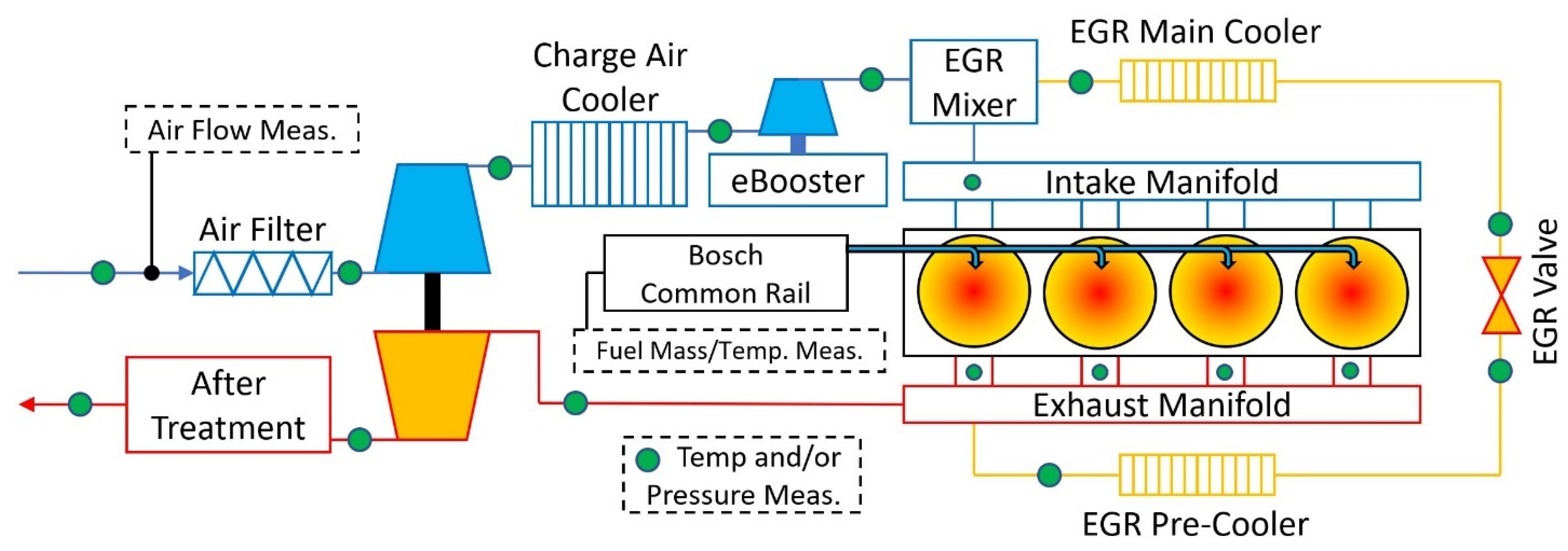
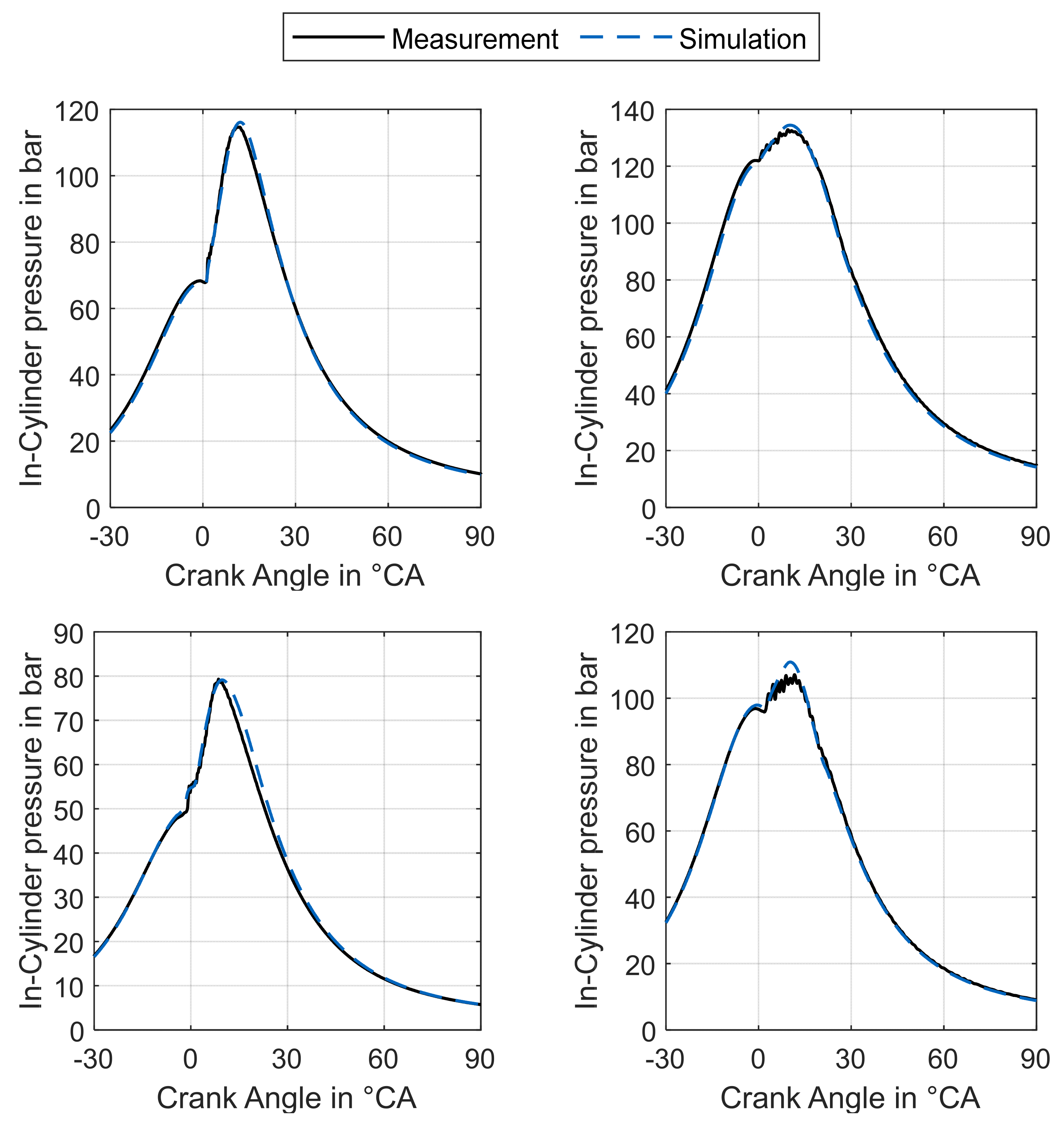
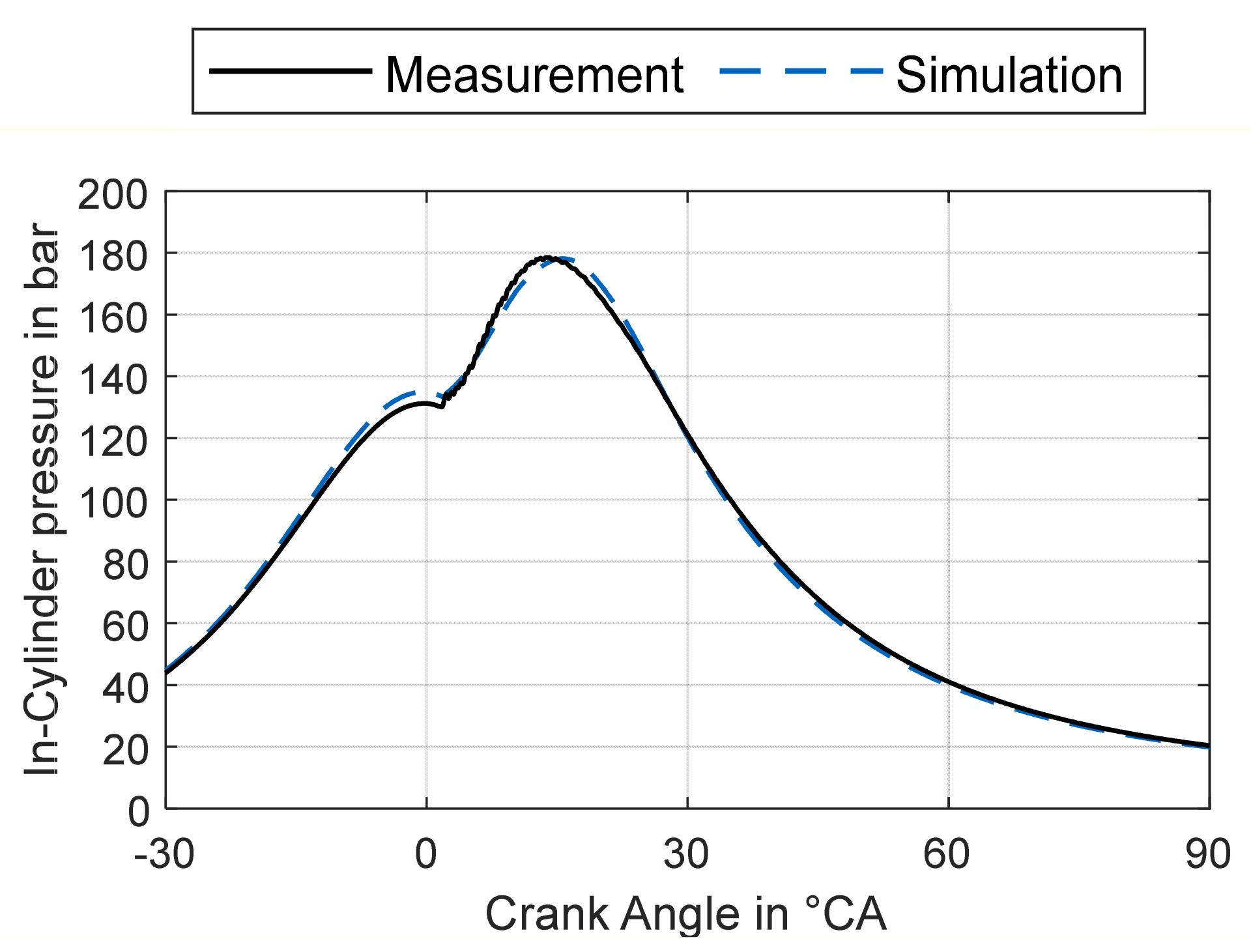

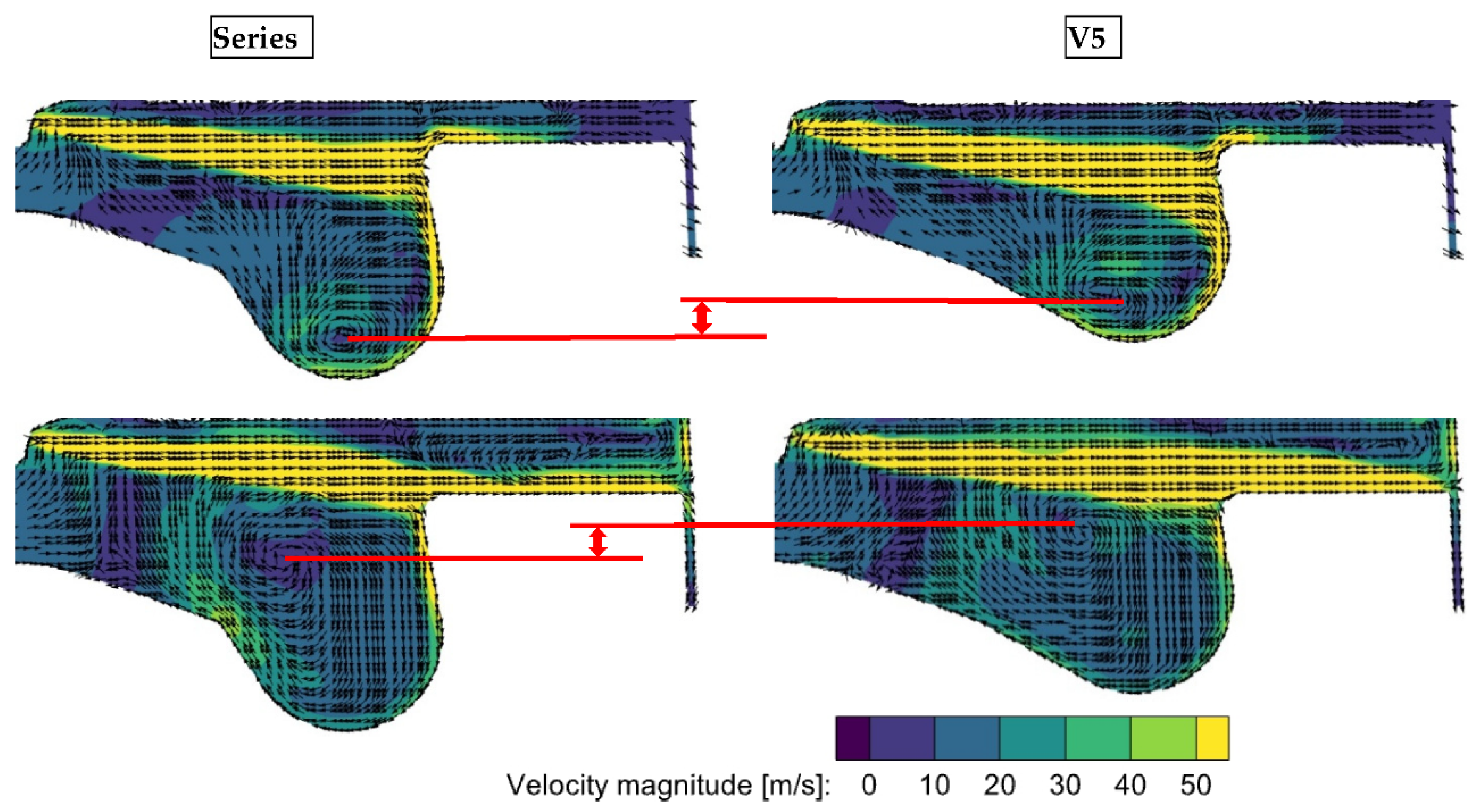
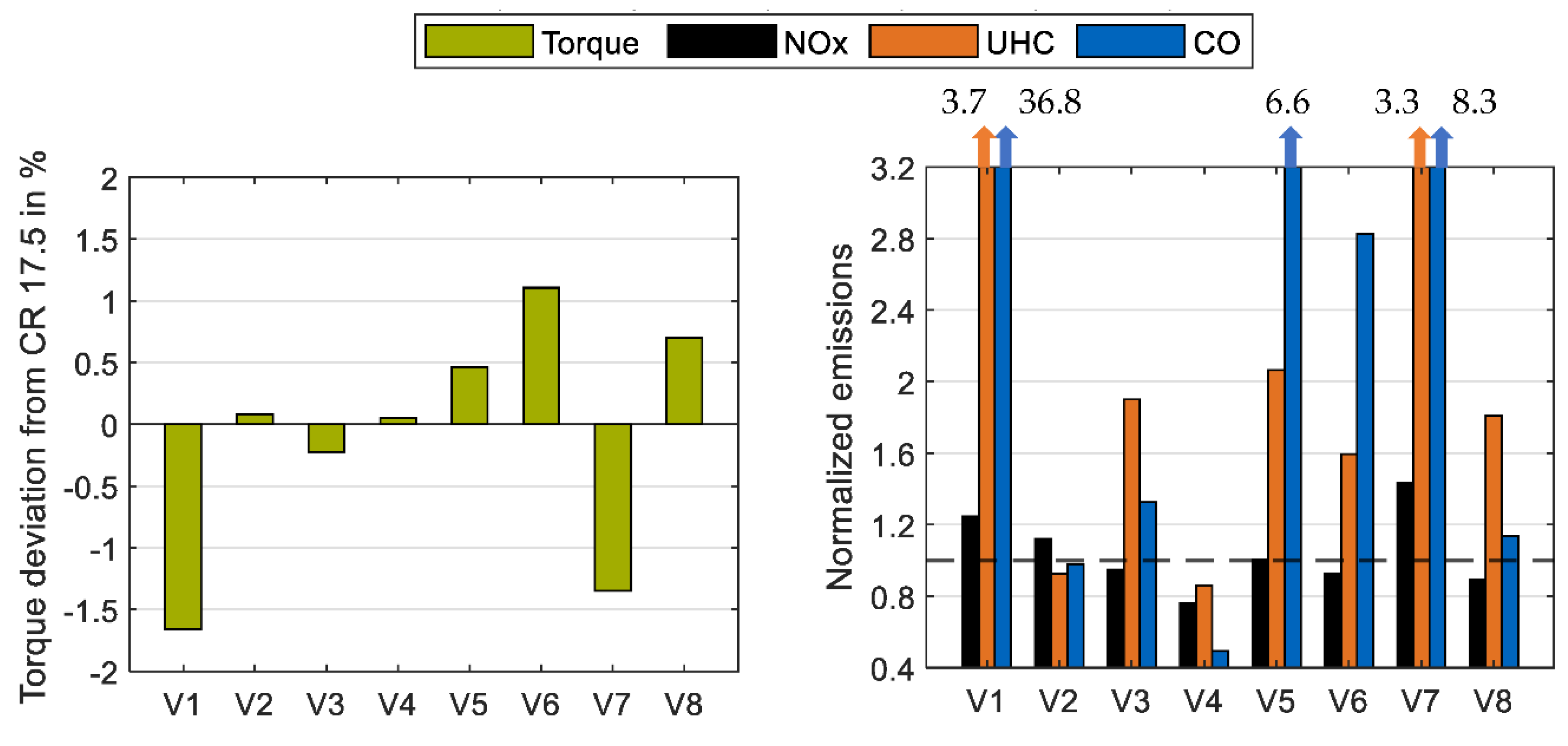
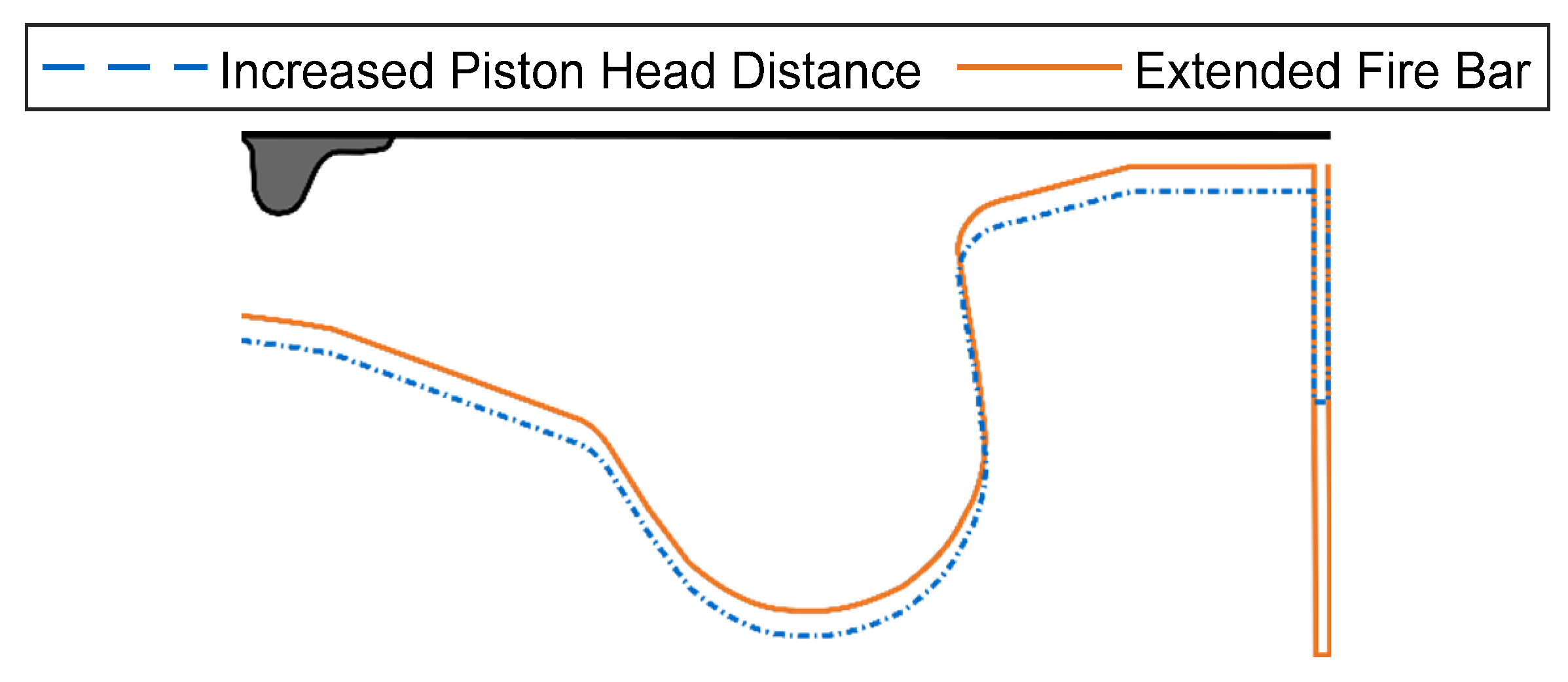
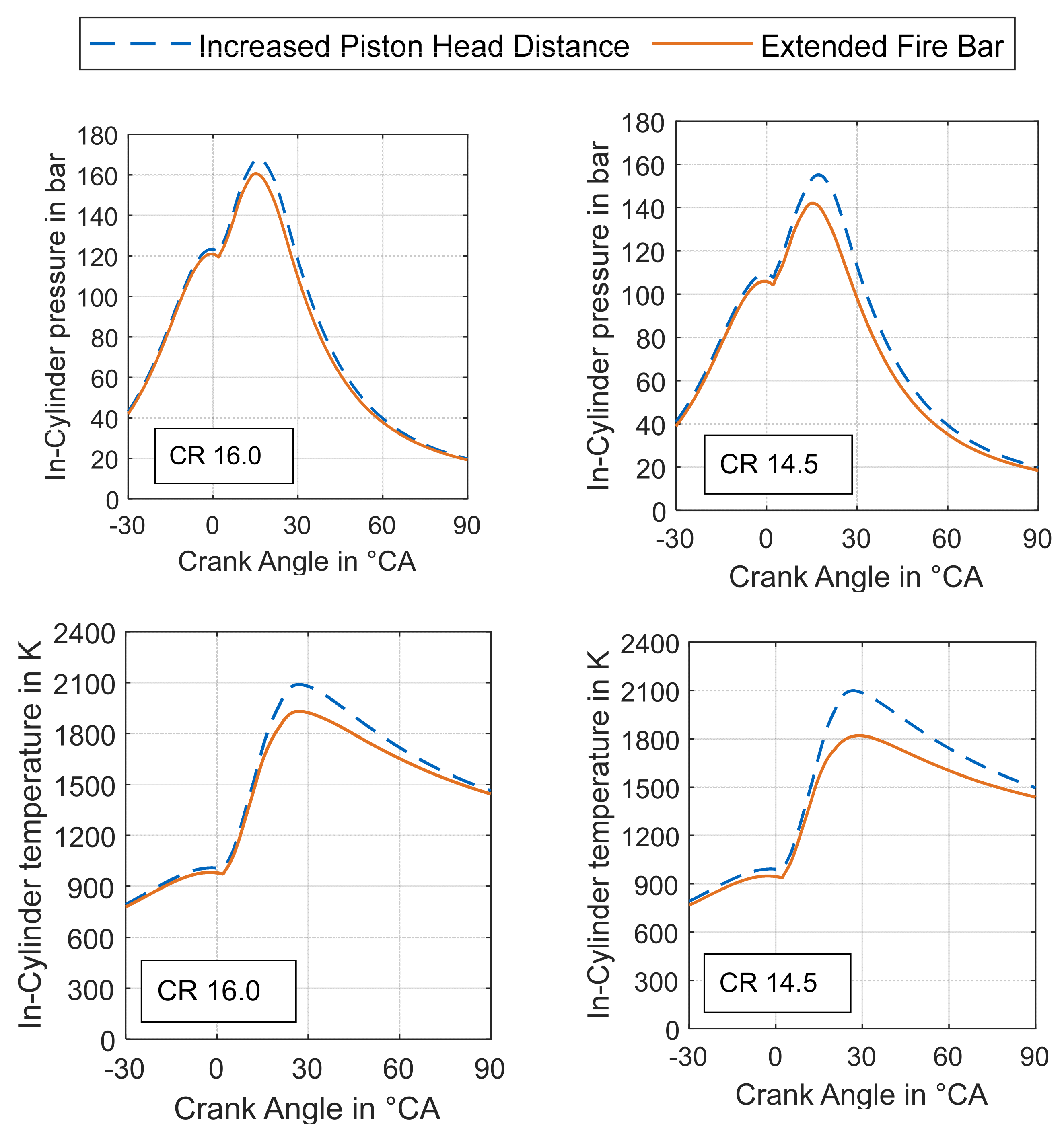
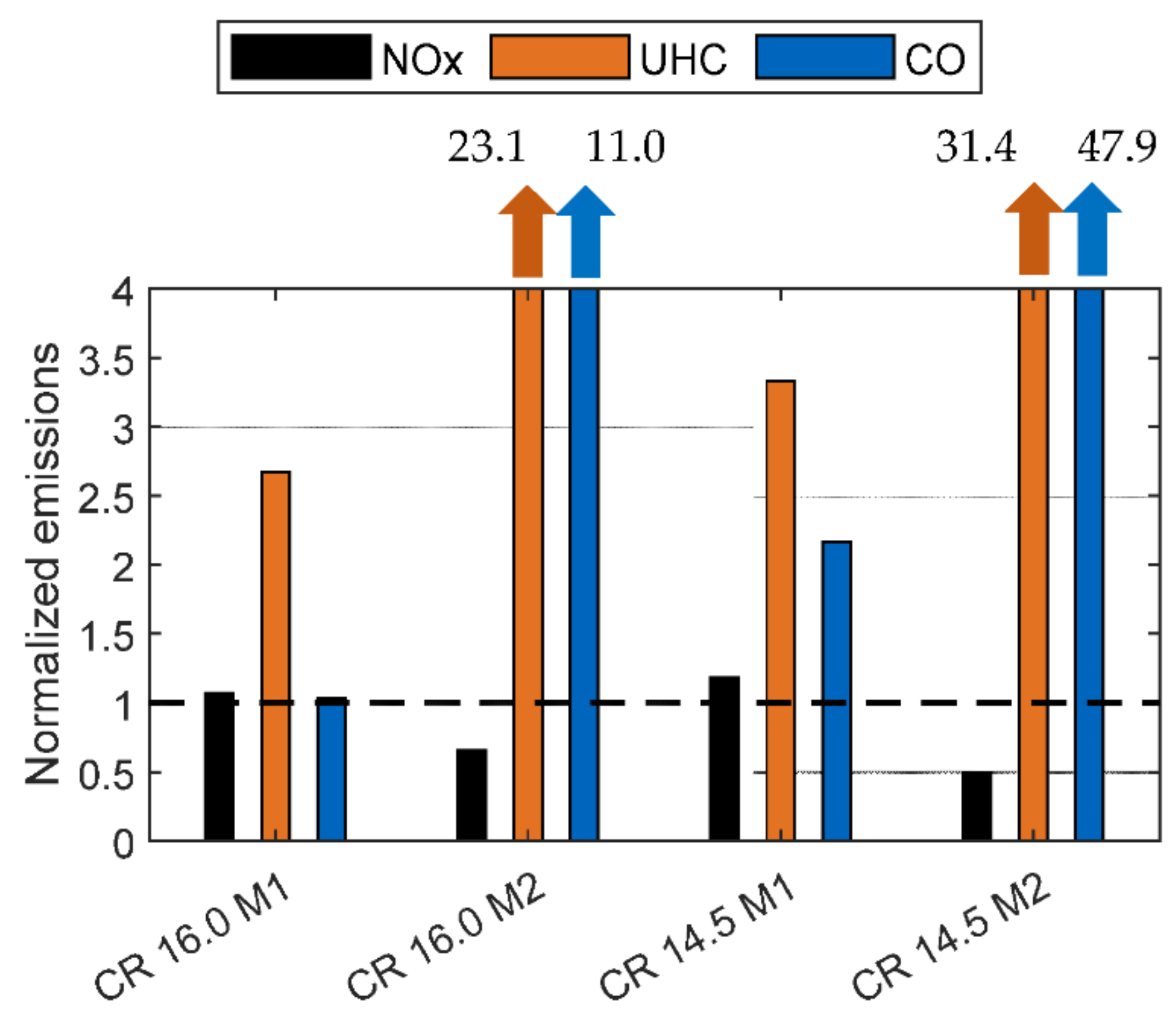
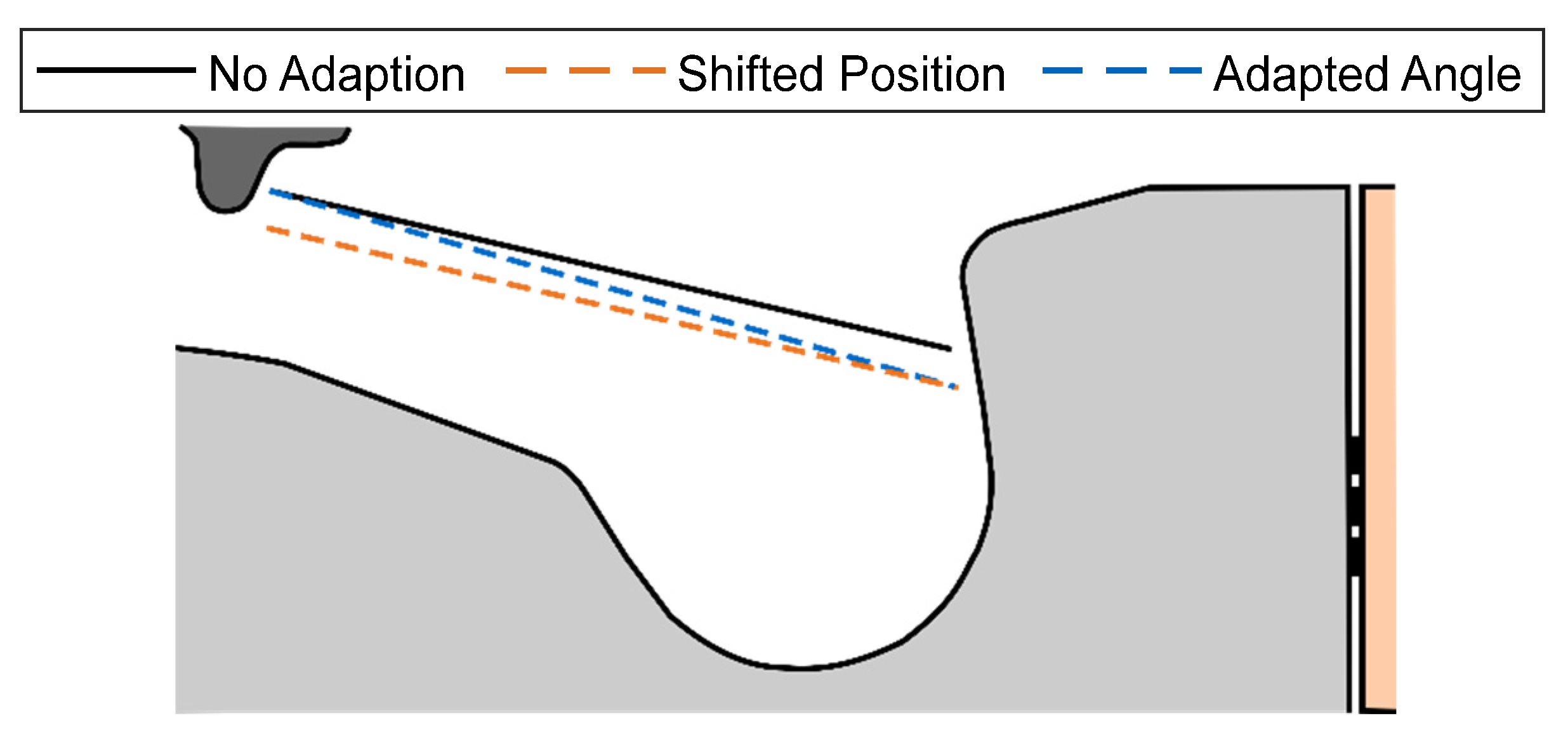



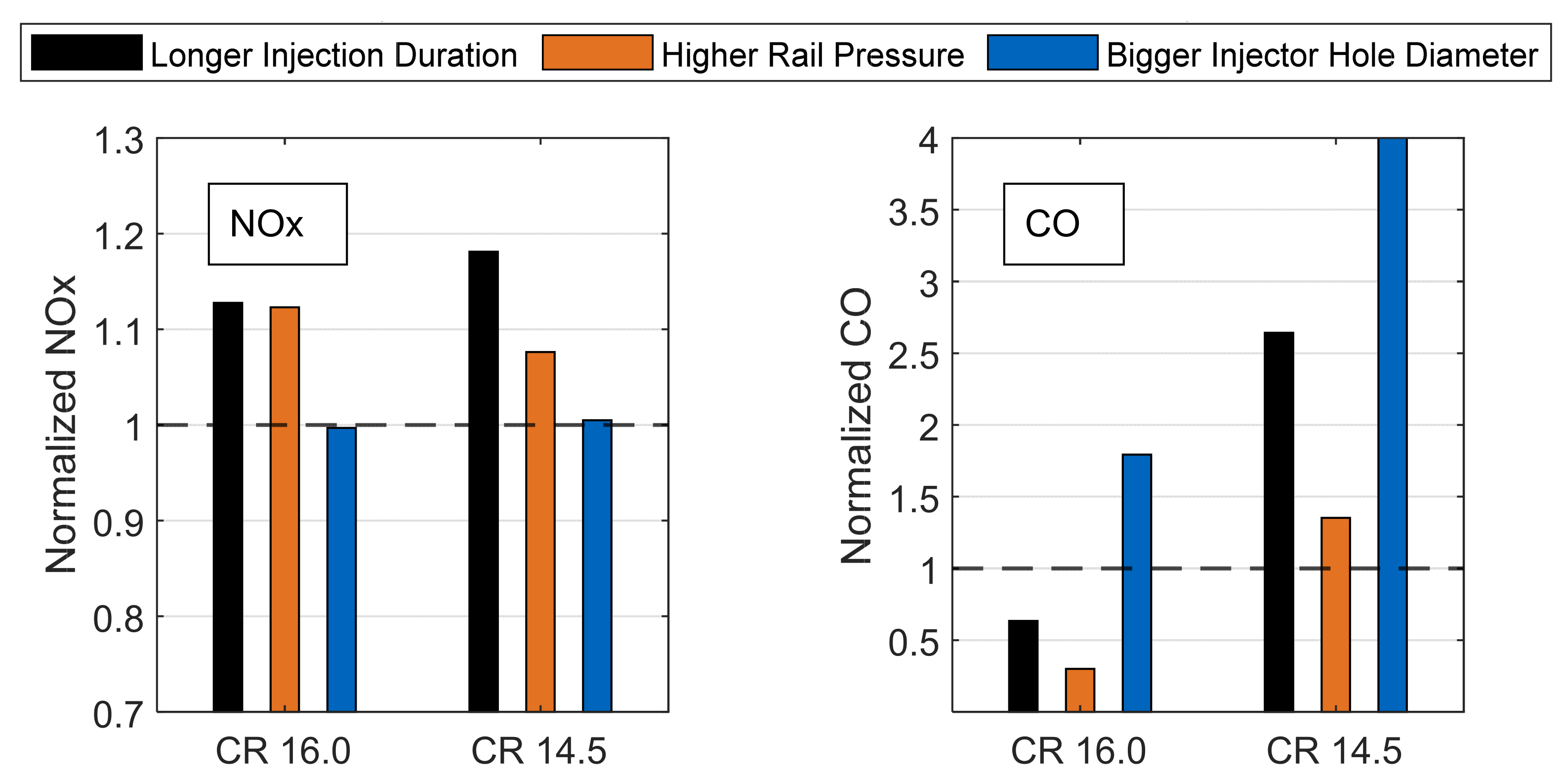
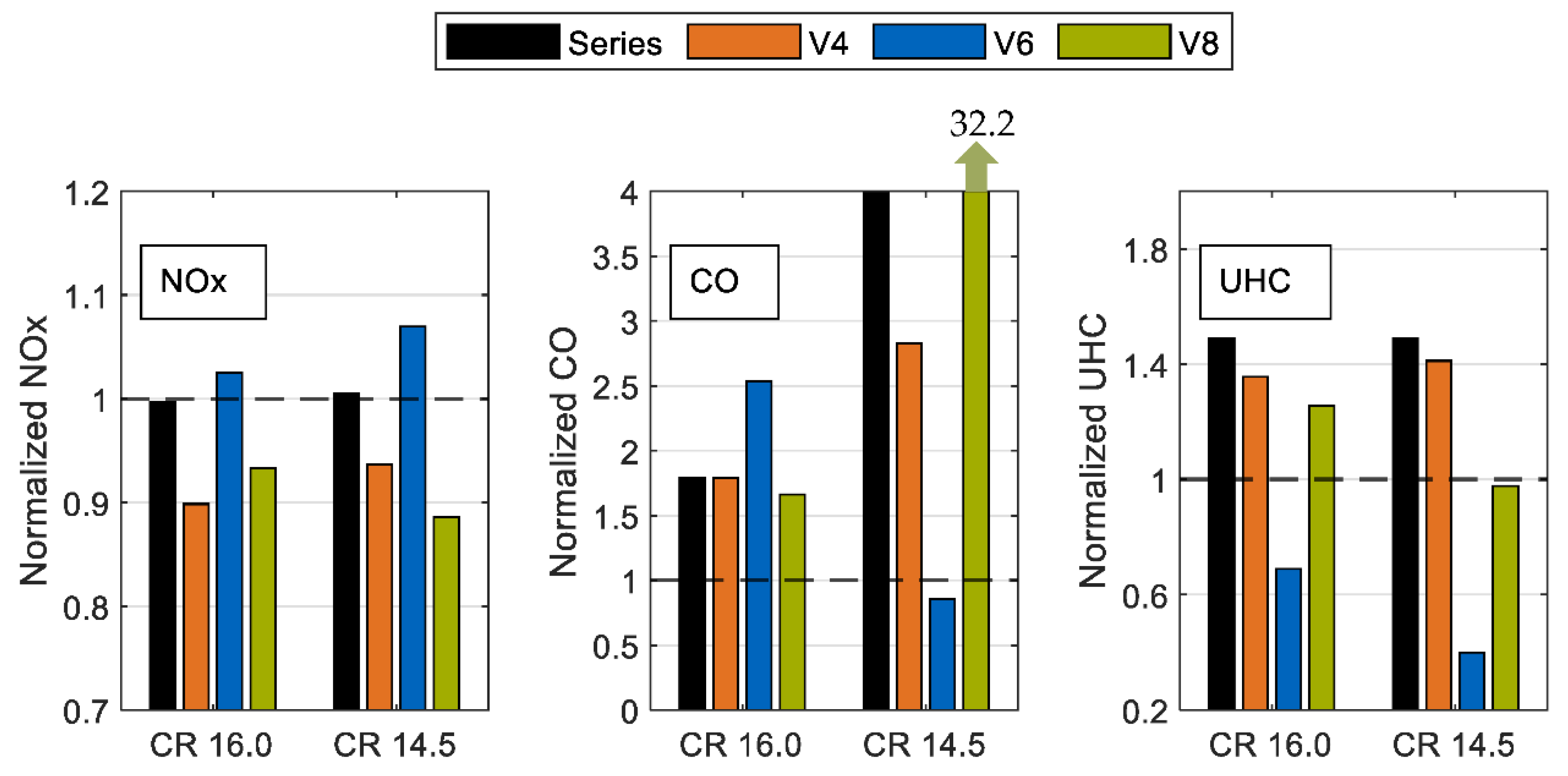
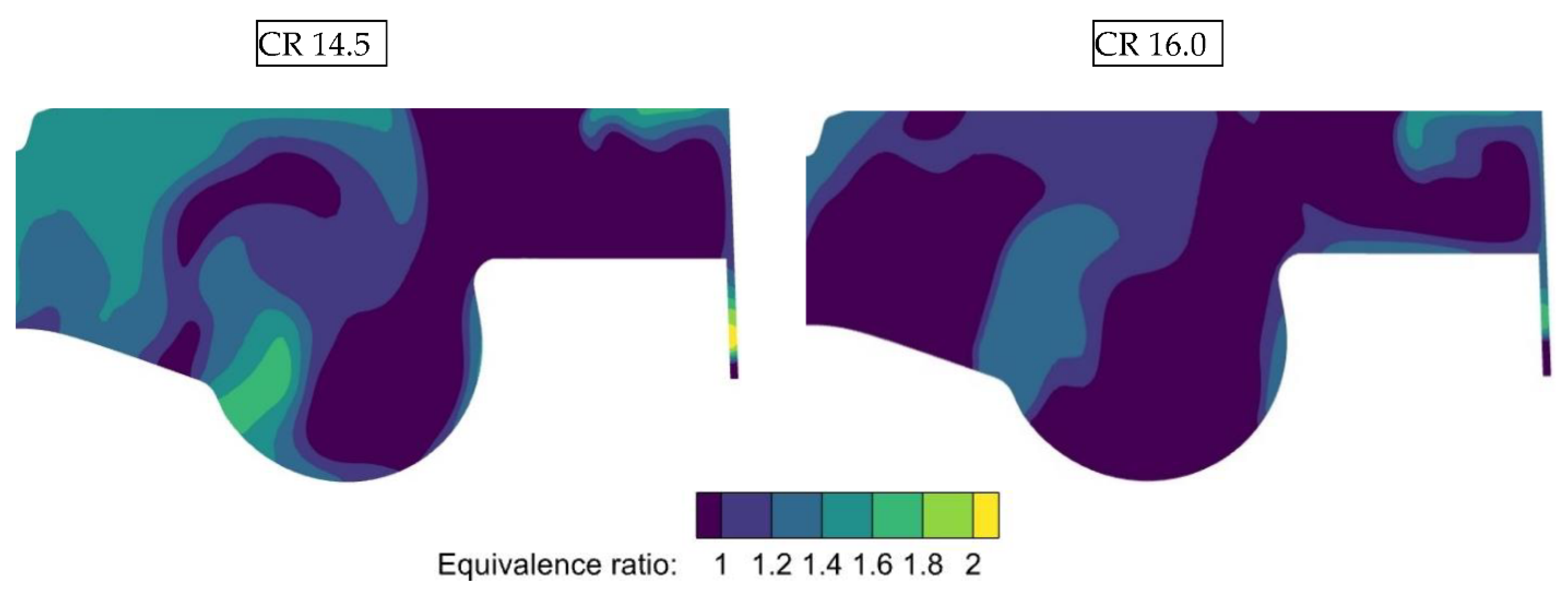
| Number/layout of cylinders | 4-stroke inline 4-cylinder |
| Displaced volume | 1985 cm3 |
| Stroke | 88 |
| Bore | 84 |
| Compression ratio | Standard: 17.5:1/Variations: 16:1 and 14.5:1 |
| Number of valves per cylinder | 2 |
| Charge | exhaust-gas-wastegate turbocharger with charge-air cooling + eBooster (two stage) |
| Exhaust-gas recirculation | Cooled high-pressure |
| Injection system | Bosch direct-inj. common rail (max. 1800 bar) |
| Injector actuation | magnetic |
| Injector-hole diameter | 0.118 mm |
| Injector holes | 7 |
| Injector-spray angle | 77° |
| Name | Mesh Size | Sub-Grid Scale | Timing |
|---|---|---|---|
| Base Size | 1.25 mm | - | Whole cycle |
| Velocity AMR | 0.625 mm | 1.5 | Whole cycle |
| Spray FE | 0.3125 mm | - | SOI—2 °CA after end of injection |
| Velocity AMR | 0.3125 mm | 0.5 | SOI—2 °CA after end of injection |
| Temperature AMR | 0.3125 mm | 2.5 | SOI—60 °CA after SOI |
| Temperature AMR | 0.625 mm | 2.5 | 60 °CA after SOI—90 °CA after SOI |
| Gross Torque in Nm | Specific NOx Emissions in g/kWh | Specific CO Emissions in g/kWh | Specific UHC Emissions in g/kWh |
|---|---|---|---|
| 401.6 | 5.5 | 0.085 | 0.009 |
| Compression Ratio | Mass-Increase Method | Fuel Mass in mg | Gross Torque in Nm | Spec. Fuel Consumption in g/kWh |
|---|---|---|---|---|
| 17.5 | - | 71 | 401.6 | 203.7 |
| 16.0 | Higher Rail Pressure | 75.5 | 422.4 | 204.8 |
| Bigger Injector-Hole Diameter | 76 | 427.0 | 204.0 | |
| Longer Injection | 77 | 429.5 | 205.4 | |
| 14.5 | Higher Rail Pressure | 80.5 | 441.6 | 208.9 |
| Bigger Injector = Hole Diameter | 82.5 | 455.1 | 207.7 | |
| Longer Injection | 87 | 474.3 | 210.2 |
| Compression Ratio | Geometry | Gross Torque in Nm | Spec. Fuel Consumption in g/kWh |
|---|---|---|---|
| 17.5 | Series | 401.6 | 203.7 |
| 16.0 | Series | 427.0 | 204.0 |
| V4 | 427.7 | 203.6 | |
| V6 | 431.0 | 202.0 | |
| V8 | 429.1 | 203.0 | |
| 14.5 | Series | 455.1 | 207.7 |
| V4 | 455.9 | 207.4 | |
| V6 | 460.8 | 205.2 | |
| V8 | 453.7 | 205.3 |
Publisher’s Note: MDPI stays neutral with regard to jurisdictional claims in published maps and institutional affiliations. |
© 2022 by the authors. Licensee MDPI, Basel, Switzerland. This article is an open access article distributed under the terms and conditions of the Creative Commons Attribution (CC BY) license (https://creativecommons.org/licenses/by/4.0/).
Share and Cite
Hatz, R.; Lukas, A.; Zepf, A.; Jaensch, M. Computational Investigation on the Performance Increase of a Small Industrial Diesel Engine Regarding the Effects of Compression Ratio, Piston Bowl Shape and Injection Strategy. Energies 2022, 15, 4674. https://doi.org/10.3390/en15134674
Hatz R, Lukas A, Zepf A, Jaensch M. Computational Investigation on the Performance Increase of a Small Industrial Diesel Engine Regarding the Effects of Compression Ratio, Piston Bowl Shape and Injection Strategy. Energies. 2022; 15(13):4674. https://doi.org/10.3390/en15134674
Chicago/Turabian StyleHatz, Raphael, Alexander Lukas, Andreas Zepf, and Malte Jaensch. 2022. "Computational Investigation on the Performance Increase of a Small Industrial Diesel Engine Regarding the Effects of Compression Ratio, Piston Bowl Shape and Injection Strategy" Energies 15, no. 13: 4674. https://doi.org/10.3390/en15134674
APA StyleHatz, R., Lukas, A., Zepf, A., & Jaensch, M. (2022). Computational Investigation on the Performance Increase of a Small Industrial Diesel Engine Regarding the Effects of Compression Ratio, Piston Bowl Shape and Injection Strategy. Energies, 15(13), 4674. https://doi.org/10.3390/en15134674






